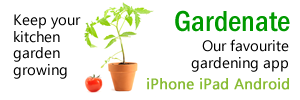Growing Tomato
Lycopersicon esculentum : Solanaceae / the nightshade family
| Jan | Feb | Mar | Apr | May | Jun | Jul | Aug | Sep | Oct | Nov | Dec |
|---|---|---|---|---|---|---|---|---|---|---|---|
| S | S | S | S | S | |||||||
| T | T | T | T | T | |||||||
| P | P | P | P |
(Best months for growing Tomato in Australia - sub-tropical regions)
- S = Plant undercover in seed trays
- T = Plant out (transplant) seedlings
- P = Sow seed
- Grow in seed trays, and plant out in 4-6 weeks. Sow seed at a depth approximately three times the diameter of the seed. Best planted at soil temperatures between 61°F and 95°F.
- Space plants: 16 - 24 inches apart
- Harvest in 8-17 weeks.
- Compatible with (can grow beside): Asparagus, Chervil,Carrot, Celery, Chives, Parsley, Marigold, Basil
- Avoid growing close to: Rosemary, Potatoes, Fennel, Cucumber

Your comments and tips